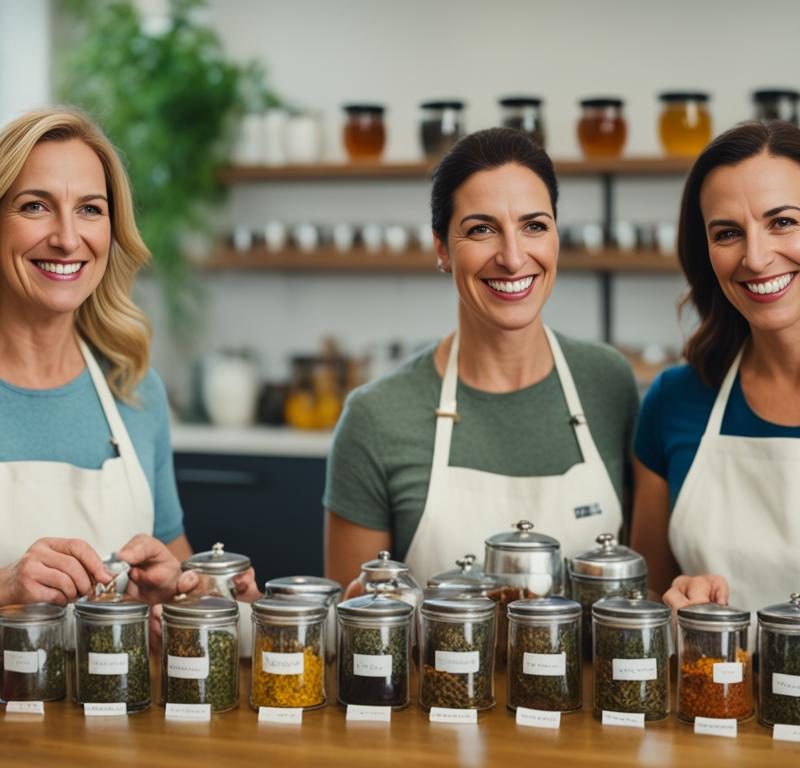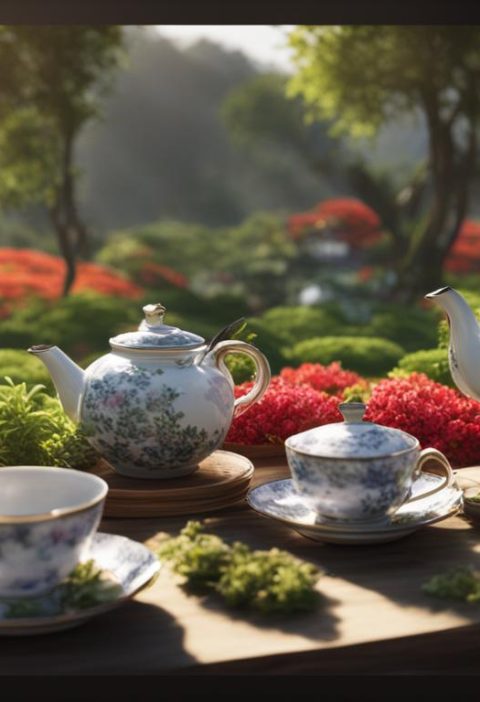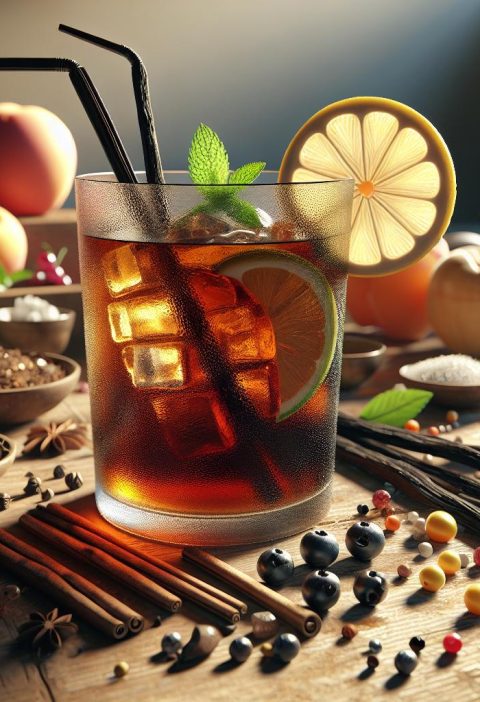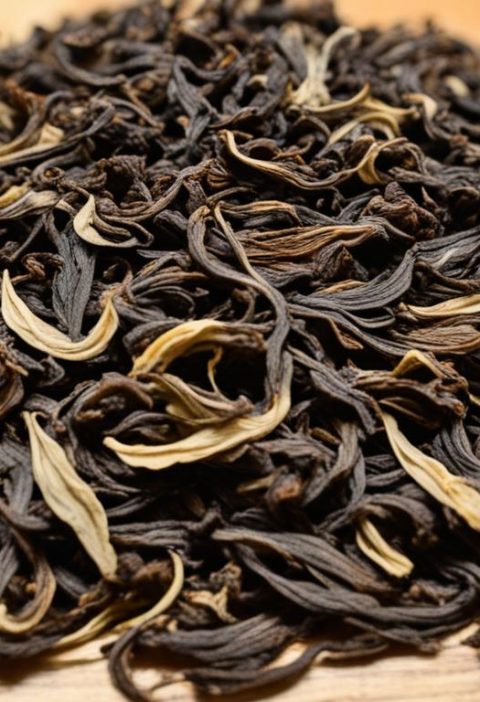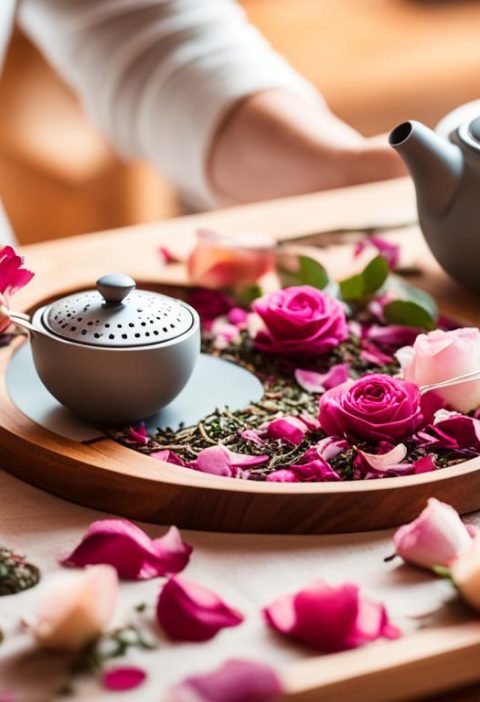Tea is a beverage with deep cultural roots that span across the globe. From the ancient Chinese tea ceremonies to the English tradition of afternoon tea, each culture has its unique practices and rituals associated with tea preparation. In this article, we will delve into the diverse world of loose leaf tea and explore the cultural traditions that surround its preparation. Whether you’re a tea enthusiast or simply curious about different tea cultures, join us as we embark on a journey to uncover the fascinating stories and practices that make loose leaf tea preparation a true art form.
Key Takeaways:
- Tea is deeply rooted in the history, culture, and society of different countries.
- There are various types of true teas made from the Camellia sinensis plant, each with its unique flavors and health benefits.
- Herbal teas offer a caffeine-free alternative and have their own cultural significance.
- Specialty and flavored teas add a twist to traditional tea blends, inviting tea enthusiasts to explore new flavor profiles.
- Each type of tea requires specific brewing techniques to bring out its optimal flavors and characteristics.
- Chinese, Japanese, and English tea cultures have their own traditions and rituals surrounding tea preparation.
- Tea cultures around the world vary, with each country having its customs, rituals, and flavors.
As a tea lover and enthusiast, I have personally explored the traditions and practices of tea preparation in various cultures. Through my own experiences and research, I have gained a deeper understanding of the significance of tea in different societies. Join me as we uncover the captivating world of cultural traditions in loose leaf tea preparation.
The Diversity of True Teas
When it comes to tea, the possibilities are endless. From bold and robust flavors to subtle and sweet profiles, there is a type of tea to suit every palate. True teas, which are derived from the Camellia sinensis plant, offer a fascinating diversity that stems from their unique processing methods.
Black Tea: Black tea undergoes full oxidation, resulting in its distinctive dark color and rich flavor. This type of tea is known for its bold taste and is often enjoyed with a splash of milk or a slice of lemon. In addition to its deliciousness, black tea is also packed with antioxidants and flavonoids that contribute to its health benefits.
Green Tea: Green tea is minimally processed and doesn’t undergo oxidation, retaining its vibrant green color and fresh taste. This delicate tea variety offers a grassy flavor profile and is celebrated for its high levels of catechin antioxidants, which are believed to have various health-promoting properties.
White Tea: White tea is made from minimally processed leaves that have no oxidation. This gentle processing method preserves the delicate flavors and subtle sweetness of the tea. White tea is also known for its high levels of antioxidants, making it a popular choice among health-conscious tea enthusiasts.
Oolong Tea: Oolong tea falls between green and black tea in terms of oxidation. The level of oxidation can vary, resulting in a wide range of flavors and aromas. Oolong teas can range from light and floral to dark and roasted, offering a unique experience with each cup.
These true teas not only offer diverse flavor profiles but also have cultural traditions associated with them. In China, the gongfu tea ceremony showcases the heritage tea brewing techniques used to prepare these teas. Similarly, the Japanese tea ceremony, known as Chanoyu, embraces the authentic tea preparation practices for green tea. The combination of cultural significance and distinct flavor profiles adds depth and richness to the tea-drinking experience.
With the wide array of true teas available, there is always something new to explore and enjoy. Whether it’s savoring the boldness of a black tea, immersing in the tranquility of a green tea ceremony, or appreciating the delicate flavors of a white tea, the world of true teas invites us to embark on a delightful journey of taste and tradition.
The World of Herbal Teas
Herbal teas, also known as tisanes, offer a caffeine-free alternative to traditional teas. Made from various herbs, flowers, and leaves of plants other than the Camellia sinensis, these teas come in a wide range of flavors and health benefits. Chamomile, peppermint, and hibiscus are well-known herbal teas that offer soothing and refreshing qualities.
Cultural Tea Infusion Rituals
Each culture has its own unique traditions and rituals when it comes to herbal tea infusion. These cultural tea infusion rituals not only enhance the enjoyment of the beverage but also provide deeper cultural meaning and significance. Here are a few examples:
- Chamomile for Relaxation: In many cultures, chamomile tea is cherished for its calming properties. It is often consumed before bedtime to promote relaxation, reduce stress, and aid in sleep. The infusion process involves steeping dried chamomile flowers in hot water for a few minutes. The resulting golden liquid is sipped slowly, allowing the gentle aroma and soothing flavors to evoke feelings of tranquility.
- Peppermint for Digestion: Peppermint tea is widely recognized for its ability to soothe digestive discomfort and alleviate bloating. Its refreshing flavor and menthol content make it a popular choice after meals in many cultures. To infuse peppermint tea, dried peppermint leaves are steeped in hot water. The resulting aromatic and invigorating beverage is enjoyed slowly, providing relief and promoting digestion.
These cultural tea infusion rituals highlight the diverse ways in which different societies incorporate herbal teas into their daily lives, drawing upon their unique flavors and therapeutic benefits.
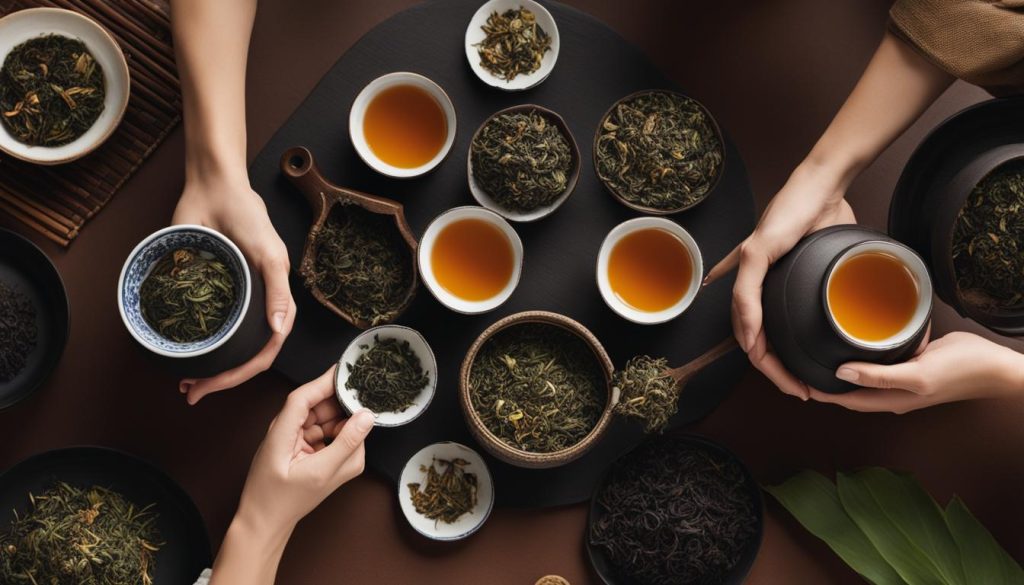
Specialty and Flavored Loose Leaf Teas
Specialty and flavored teas offer a unique twist on traditional tea varieties. These teas are crafted with care and creativity to provide tea enthusiasts with a world of exciting flavors and aromas. Whether you prefer classic tastes or innovative combinations, there is a specialty tea blend for everyone.
Traditional Scented Teas
Traditional scented teas have a long history and are beloved for their captivating aromas. These teas are skillfully infused with natural scents, creating a sensory experience unlike any other. Fragrant jasmine tea, for example, blends delicate green tea leaves with the scent of jasmine flowers, resulting in a floral and soothing cup of tea. Scented teas offer a glimpse into the artistry of tea blending and add an additional layer of sensory pleasure to your tea-drinking experience.
Modern Flavored Blends
With the rise of the specialty tea market, modern flavored blends have gained popularity among tea enthusiasts. These teas combine the rich and complex flavor profiles of traditional tea leaves with exciting ingredients such as fruits, spices, and herbs. The possibilities are endless – from the vibrant, citrusy notes of bergamot in Earl Grey tea to the warm and comforting spices of a chai blend. Modern flavored blends provide a delightful and innovative twist on traditional tea, making each sip a unique and memorable experience.
Crafting Unique Flavor Profiles
Creating specialty tea blends requires a delicate balance of art and science. Tea blenders carefully select and combine different tea leaves and ingredients to craft unique flavor profiles. The goal is to enhance the natural character of the base tea while adding complementary flavors and aromas. Each blend is meticulously crafted to ensure a harmonious and satisfying taste experience. Whether you enjoy a subtle and nuanced cup of tea or a bold and adventurous blend, specialty teas offer a wide range of flavor profiles to suit every palate.
| Specialty Tea Blends | Description |
|---|---|
| Jasmine Green Tea | A fragrant blend of green tea leaves and jasmine flowers, known for its calming and floral aroma. |
| Earl Grey | A classic black tea infused with bergamot oil, boasting a citrusy and refreshing flavor. |
| Chai Blend | A robust blend of black tea and spices like cinnamon, cardamom, and cloves, offering a warm and invigorating taste. |
| Fruit Infusion | A blend of dried fruits, herbs, and hibiscus, providing a naturally sweet and refreshing cup of tea. |
| Smoky Lapsang Souchong | A bold black tea with a distinct smoky flavor, achieved by drying the tea leaves over pine fires. |
Each specialty blend invites you to embark on a sensory journey, exploring the world of flavors and aromas that the tea world has to offer. Whether you prefer the time-honored scented teas or the boldness of modern flavored blends, specialty teas allow you to discover new tastes, expand your tea collection, and elevate your tea-drinking experience.
Brewing Techniques for Different Types of Loose Leaf Teas
Brewing tea correctly is important to unlock its unique taste and aroma. Different types of teas require specific water temperatures and steeping times. Here, we will guide you through the optimal brewing techniques for various types of loose leaf teas, ensuring you achieve the perfect cup every time.
Black Tea:
Black tea, known for its bold flavors, requires near boiling temperature and 3 to 5 minutes of steeping time. This longer steeping time allows the flavors to fully develop, delivering a robust and satisfying cup of tea.
Green Tea:
Green tea, delicate in flavor, needs lower water temperatures ranging from 70°C to 80°C (158°F to 176°F). Steep green tea for 1 to 3 minutes to prevent the leaves from becoming bitter. This shorter steeping time preserves the tea’s freshness and brings out its natural sweetness and subtle nuances.
White Tea:
White tea, known for its subtle flavor and delicate aroma, requires a similar water temperature range of 70°C to 80°C (158°F to 176°F) like green tea. However, longer steeping times of 4 to 5 minutes are recommended to fully extract the flavors and delicate essence of the tea leaves.
Oolong Tea:
Oolong tea, a balance between green and black tea, benefits from water temperatures of 80°C to 90°C (176°F to 194°F) and steeping times of 2 to 5 minutes, depending on the variety. This allows the tea to develop its unique flavors, from light and floral to dark and roasted.
Each type of tea has its own optimal brewing technique, carefully calibrated to bring out its distinct flavors and characteristics. By following these guidelines, you can ensure that each cup of tea you brew is a delightful and satisfying experience.
Chinese Tea Culture
China has a rich and ancient tea culture that spans thousands of years. Tea is deeply ingrained in Chinese society and holds a special place in the hearts of its people. Chinese tea houses, bustling with activity, are vibrant centers of socialization where friends and families gather to relax, engage in lively conversations, and enjoy the art of tea. These tea houses offer an immersive experience, where visitors can savor a wide variety of teas while indulging in traditional snacks and desserts.
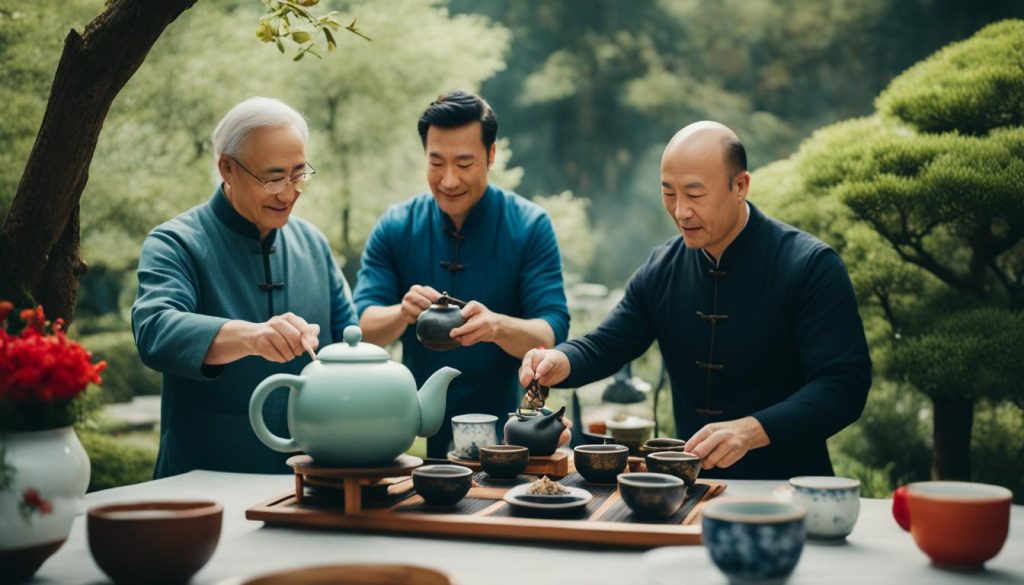
Gongfu Tea Ceremony
One of the most revered tea rituals in China is the Gongfu tea ceremony. With its origins in the Fujian province, the Gongfu tea ceremony is a meticulous and elegant art form that involves skilled and precise brewing techniques. The ceremony emphasizes harmony, respect, and patience, as tea is brewed using smaller vessels and a higher leaf-to-water ratio. Each step, from heating the teaware to pouring the tea, is carefully performed, creating an exquisite sensory experience for participants.
The Gongfu tea ceremony allows individuals to appreciate the beauty of tea as they watch the leaves unfurl and release their delicate flavors and aromas. It fosters a sense of connection with nature and provides a tranquil space for relaxation and reflection. By practicing the Gongfu tea ceremony, participants immerse themselves in the rich tapestry of Chinese tea culture, expanding their knowledge and appreciation of this timeless tradition.
| Chinese Tea Culture | Chinese Tea Houses | Gongfu Tea Ceremony |
|---|---|---|
| Deeply rooted in Chinese society and history | Vibrant centers of socialization | Meticulous and elegant tea ritual |
| Offers an immersive tea experience | Relaxation and enjoyment of a wide variety of teas | Emphasizes harmony, respect, and patience |
| Celebration of the art of tea brewing | Indulgence in traditional snacks and desserts | Creates an exquisite sensory experience |
| Connects individuals with nature | Space for reflection and tranquility | Expands knowledge and appreciation of tea culture |
Japanese Tea Culture
Japan’s rich tea culture is deeply influenced by Zen philosophy, emphasizing grace, tranquility, and an appreciation for simplicity.
The centerpiece of Japanese tea culture is the revered Japanese tea ceremony, also known as Chanoyu or Sado. This spiritual ritual involves meticulous movements and gestures that create a meditative and harmonious experience for both the host and guests.
At the heart of the Japanese tea ceremony is Matcha, a powdered green tea known for its vibrant color and unique flavor. Matcha is finely ground from shade-grown tea leaves, resulting in a smooth and velvety texture.
The art of the Japanese tea ceremony requires a high level of precision and attention to detail. Each movement, from the way the tea is scooped, whisked, and poured, signifies respect, mindfulness, and a deep connection with nature.
Drinking Matcha has become a way for individuals to cultivate focus, mindfulness, and a sense of harmony in Japanese culture. It is a symbol of elegance, refinement, and the pursuit of inner serenity.
Benefits of Matcha
Matcha offers various health benefits due to its unique preparation and consumption method. Because the tea leaves are consumed whole, Matcha delivers a more concentrated dose of antioxidants and beneficial compounds compared to steeped teas.
Here are some key benefits of Matcha:
- Rich in antioxidants: Matcha is packed with catechins, a type of antioxidant that helps protect the body against free radicals and oxidative stress.
- Boosts energy and focus: Matcha contains a moderate amount of caffeine, providing a gentle energy boost without the jittery side effects of coffee.
- Promotes relaxation: Matcha also contains L-theanine, an amino acid that promotes a state of relaxation and calmness.
- Supports detoxification: The high chlorophyll content in Matcha helps flush out toxins from the body and supports healthy liver function.
Incorporating Matcha into your daily routine can provide a nourishing and rejuvenating experience, both for the body and the mind.
Stay tuned as we explore more fascinating tea cultures from around the world!
English Tea Culture
Tea holds a special place in English culture and is deeply ingrained in daily life. Afternoon tea, popularized by the Duchess of Bedford in the 19th century, is a cherished tradition that involves enjoying tea along with sandwiches, scones, and pastries. English breakfast tea, a blend of black teas, is often enjoyed with milk and sugar. The brewing of tea in England has become a symbol of relaxation, elegance, and social gathering. Tea is a quintessential part of British identity and a beloved national drink.
Afternoon Tea
Afternoon tea is a time-honored tradition in England that emerged during the Victorian era. It was the Duchess of Bedford, Anna, who introduced the idea of having tea and light snacks in the afternoon to overcome the “sinking feeling” between lunch and dinner. This delightful ritual quickly gained popularity among the upper classes and eventually spread to all social classes.
The afternoon tea experience typically includes a selection of finger sandwiches, freshly baked scones served with clotted cream and strawberry jam, and a variety of pastries and cakes. The teas served during afternoon tea are often a combination of black tea blends such as Earl Grey, Darjeeling, and Assam. This elegant affair is commonly enjoyed in hotels, tea rooms, and even private homes throughout England.
English Breakfast Tea
English breakfast tea is a robust blend of black teas, typically Assam, Ceylon, and Kenyan teas. This full-bodied blend is known for its rich flavor and dark amber color. It is often enjoyed with a splash of milk and a touch of sugar, although preferences may vary. English breakfast tea is a staple in English households and is commonly consumed in the mornings to kick-start the day.
English breakfast tea is a true classic and has gained worldwide recognition for its comforting and invigorating qualities. It pairs well with traditional English breakfast dishes such as bacon, eggs, and toast. Many tea lovers around the globe appreciate the bold taste and smoothness of English breakfast tea.
| Key Features of English Tea Culture | Afternoon Tea | English Breakfast Tea |
|---|---|---|
| Definition | An elegant tradition of enjoying tea, sandwiches, scones, and pastries in the afternoon. | A robust blend of black teas typically consumed in the morning. |
| Typical Serving | Finger sandwiches, scones with clotted cream and jam, pastries, and cakes. | Plain or with milk and sugar, paired with a hearty English breakfast. |
| Flavor Profile | Varied flavors depending on the teas used, often lighter and milder. | Full-bodied and rich, with a bold and invigorating taste. |
| Social Significance | A symbol of refinement, elegance, and social gatherings. | A beloved national drink associated with relaxation and morning rituals. |
Tea Culture Around the World
Tea is not just a beverage; it’s a global phenomenon that unites people from diverse cultures. While China, Japan, and England may be the first countries that come to mind when we think of tea, there are other fascinating tea cultures to explore. In Thailand, Thai iced tea, or cha-yen, is a popular drink made from strong black tea infused with flavors like orange blossom and cinnamon. It provides a refreshing respite from the hot weather, making it a favorite among locals and visitors alike.
Meanwhile, in the vibrant country of Morocco, tea plays a significant role in daily life. Moroccan mint tea, also known as Touareg tea, is a symbol of hospitality and a testament to Moroccan culture. Served in tall glasses over three servings, this hot mint tea carries deep meaning and reflects on life’s aspects like love, bitterness, and sweetness. It is a delightful and cherished ritual that invites people to connect and bond over a steaming cup of tea.
Tea culture varies widely around the world, with each country infusing its own customs, rituals, and flavors into the tea-drinking experience. Whether it’s the bold and refreshing Thai iced tea or the aromatic and symbolic Moroccan mint tea, these unique brews offer a glimpse into the diverse cultures that embrace tea in their own special ways. So, as you explore the world of tea, don’t miss the chance to indulge in these fascinating and flavorful tea traditions!
